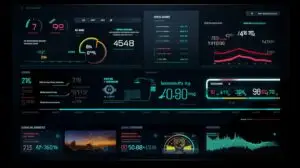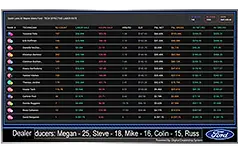A Sales BDC Dashboard is a tool. It shows important info about sales. This happens in an easy way to understand.
The dashboard can show which areas need more work. This helps the team sell more and better products or services.
Table of Contents
ToggleBenefits of using a sales BDC dashboard
A sales BDC dashboard offers many benefits to improve performance and increase sales. With a dashboard, you can easily track important sales metrics like calls, appointments, and lead generation.
It provides a visual representation of data, making it easier to understand trends and identify areas for improvement. By prioritizing customer engagement based on the information provided by the dashboard, you can better meet their needs and boost sales.
A BDC dashboard also allows you to measure the performance of your sales team, identify strengths and weaknesses, and provide targeted training to improve skills. Overall, using a sales BDC dashboard helps streamline the sales process, optimize efficiency, and drive success in your business.
How to Create a Sales BDC Dashboard
To create a Sales BDC Dashboard, start by determining which sales metrics to track and identifying the intended use of the dashboard. Then, choose a provider, pull data, and build reports based on the selected metrics.
Embarking on the creation of a Sales BDC Dashboard involves a strategic process that begins with meticulous consideration of the sales metrics to monitor and a clear understanding of the dashboard’s intended purpose.
Dive into the intricacies of data extraction, pulling valuable insights to populate your dashboard effectively.
Elevate the user experience by constructing detailed reports centered around the chosen metrics, ensuring that your Sales BDC Dashboard becomes not just a tool but a comprehensive guide for informed decision-making and performance optimization.
Determine which sales metrics to track

To effectively utilize a Sales BDC Dashboard, it is important to determine which sales metrics to track. Instead of just focusing on sales figures and the number of appointments, consider including other metrics that can provide valuable insights into your team’s performance.
For example, tracking calls made, sales appointment conversions, service appointment management, online lead conversion rates, and after-hours lead contact can help prioritize customer engagement and measure BDC agent performance.
By analyzing these key metrics, you can identify areas for improvement and take specific actions to boost your overall sales performance.
Identify the intended use of the dashboard

A sales BDC dashboard is designed to help businesses track and improve their sales performance. By identifying the intended use of the dashboard, you can determine what specific metrics and information you need to focus on.
For example, if your goal is to increase customer engagement, you might want to track metrics like online leads and onsite appointments. On the other hand, if you want to measure the performance of your BDC agents, metrics like calls made and sales conversion rate would be important.
Knowing the intended use of your dashboard will guide you in selecting the right data to monitor and analyze for better sales results.
Choose a provider

To create a Sales BDC Dashboard, you need to choose a provider that offers the right tools and features for your needs. Look for a provider that specializes in sales dashboards and has experience working with businesses like yours.
Consider their track record, customer reviews, and pricing options. Make sure the provider can integrate with your existing systems and data sources. This will ensure that you can easily pull data from different sources to build comprehensive reports on sales metrics and performance.
Remember, choosing the right provider is crucial for creating an effective dashboard that helps improve performance and increase sales.
Pull data and build reports

To create a Sales BDC Dashboard, you need to pull data and build reports. This involves gathering information from different sources and organizing it in a visual representation. You can track sales metrics like calls, sales appointments, service appointments, online leads, and more.
By prioritizing these metrics and analyzing the data, you can identify areas for improvement and make informed decisions to boost performance. Building reports allow you to monitor progress over time and identify trends or patterns that can help increase sales.
10 Sales Dashboard Examples

Here are 10 examples of sales dashboards that can help you track and improve your team’s performance. From sales conversion rates to win/loss analysis, these metrics will give you valuable insights into your sales process.
Sales conversion rate
The sales conversion rate is an important metric to track on your Sales BDC Dashboard, as it indicates the percentage of leads that result in a sale. By monitoring this metric, you can assess the effectiveness of your sales team and identify areas for improvement.
A high conversion rate means that your team is successfully closing deals, while a low conversion rate may indicate issues with lead quality or sales techniques. Use the dashboard to analyze and compare conversion rates over different time periods, such as monthly or quarterly, to see trends and make data-driven decisions to boost sales performance.
Sales rep performance
Sales rep performance is a crucial aspect of any business. To improve sales, it’s important to track and evaluate the performance of your sales reps. A Sales BDC Dashboard can provide valuable insights into their performance by measuring metrics like calls made, sales appointments set, and customer engagement.
By prioritizing these metrics and regularly monitoring them through the dashboard, you can identify areas for improvement and take steps to boost your sales team’s performance. Providing training and support based on the data from the dashboard can help sales reps improve their skills and ultimately increase sales for your business.
Sales manager overview
A sales manager overview is a key feature of a Sales BDC Dashboard. It allows sales managers to have a clear and comprehensive view of the sales team’s performance. With this overview, managers can easily track important metrics like conversion rates, individual sales rep performance, and appointments won or lost.
By having access to these metrics in real-time, sales managers can quickly identify areas for improvement and take proactive steps to boost team productivity and increase sales. This helps the entire team stay focused on their goals while also providing valuable insights for making data-driven decisions that drive success.
Win/loss analysis

Win/loss analysis is an important component of a sales BDC dashboard. It helps businesses understand why they win or lose deals, providing valuable insights for improving their sales performance.
By analyzing the reasons behind each outcome, companies can identify areas of strength and weakness in their sales process, messaging, and overall strategy. This analysis allows them to make data-driven decisions on how to prioritize resources, train their team members effectively, and refine their approach to better engage with customers.
Ultimately, win/loss analysis helps businesses improve their sales efficiency and increase overall success rates.
Time-tracking
![]()
Tracking time is an important aspect of using a Sales BDC Dashboard to improve performance and increase sales. By monitoring the amount of time spent on various activities, such as calls, appointments, and lead generation, businesses can identify areas for improvement and prioritize their efforts.
Time tracking allows businesses to measure the efficiency of their sales team, identify any bottlenecks in the sales process, and ensure that each customer receives proper attention.
By utilizing time-tracking metrics in a Sales BDC Dashboard, businesses can make data-driven decisions to boost performance and maximize productivity.
Tips for Effective Sales Dashboard Design

Designing an effective sales dashboard involves incorporating a clean layout, including calculations, ensuring accessibility, focusing on accurate reporting, and utilizing additional resources for understanding sales metrics and KPIs.
In the world of making a Sales BDC Dashboard, start by figuring out the important sales metrics for your business goals. This sets the stage for a dashboard that’s not just about numbers but about understanding your sales in a practical way. Consider how you plan to use the dashboard, aiming for a solution that fits your sales needs.
Then, find a provider that fits well with what you need. Choose a partner wisely, someone who can handle your current needs and grow with you in the future. When it comes to getting the data, be thorough. Collect insights from different sources to ensure you have a well-rounded view.
As you put together your Sales BDC Dashboard, think about how it looks and feels for the user. Create an experience that’s not just informative but also engaging.
Build detailed reports around the metrics you’ve chosen, offering a broad view of your sales. In this creation process, turn your Sales BDC Dashboard into a helpful guide, leading your team through the details of analyzing performance and making smart decisions.
Clean layout

A clean layout is important when creating a sales BDC dashboard. It helps to present information in a clear and organized way, making it easier for users to understand and navigate the dashboard.
With a clean layout, users can quickly locate the metrics they need and make data-driven decisions. It also improves readability and reduces visual clutter, ensuring that the most relevant information stands out.
By keeping the design simple and user-friendly, a clean layout enhances usability and overall user experience.
Inclusion of calculations

Calculations play a crucial role in creating an effective sales BDC dashboard. By including calculations, you can transform raw data into meaningful insights that drive decision-making.
You can calculate the sales conversion rate to measure how many leads are being converted into actual sales. This allows you to identify areas for improvement and make necessary adjustments to boost performance.
Including calculations for sales rep performance can help track individual success and identify any training needs. Overall, incorporating calculations in your sales BDC dashboard provides valuable information that can lead to improved performance and increased sales.
Accessibility

An essential aspect of designing a sales BDC dashboard is ensuring its accessibility. This means making sure that the dashboard can be easily understood and used by everyone who needs to access it.
A clean layout with clear labels and intuitive navigation can help users quickly find the information they need. It’s also important to include calculations within the dashboard so users don’t have to perform calculations themselves manually.
Accurate reporting is crucial for an effective sales BDC dashboard as it provides reliable data for decision-making. By prioritizing accessibility, businesses can maximize the benefits of their sales BDC dashboards and improve performance across the board.
Importance of accurate reporting
Accurate reporting is crucial when using a Sales BDC Dashboard to improve performance and increase sales. With accurate data, businesses can make informed decisions and take effective actions to boost sales.
It helps in evaluating the success of different strategies and identifying areas for improvement. Accurate reporting also ensures transparency and accountability within the sales team, allowing managers to measure individual and overall performance accurately.
By tracking key metrics with precision, businesses can identify trends, set realistic goals, and make adjustments as needed to achieve optimal results.
Conclusion – How to Use a Sales BDC Dashboard
Using a Sales BDC Dashboard is key to improving performance and increasing sales. By tracking important metrics, analyzing data in real-time, and making informed decisions, businesses can optimize their sales process.
With the right dashboard design and training, companies can effectively monitor their performance and take proactive steps to achieve their goals. So start using a Sales BDC Dashboard today and see how it can boost your sales!
FAQs
1. What is a Sales BDC Dashboard?
A Sales BDC Dashboard, part of the Business Development Center, is a business tool used for sales tracking and performance measurement to improve sales performance.
2. How can I use a BDC dashboard to track my sales team’s activities?
You can use your dashboard’s sales appointment tracking feature to monitor the actions of your team. It also helps measure BDC agent performance.
3. Will using a sales dashboard help in boosting my business’ performance?
Yes! A properly used sales dashboard helps you understand your afterhour leads, customer engagement prioritization, and other key metrics that aid in boosting performance.
4. Can I streamline my sale cycle using CRM with this dashboard?
Absolutely! Combining CRM tools with your business development center’s analytics will streamline the entire sale process.
5. Will it be beneficial in managing complex data like customer interactions and total earnings?
Yes! Sales analysis benefits from such dashboards because they filter multiple data types into easy-to-read metrics for better decision-making.

Alexi Walters is a trailblazing technology journalist known for her insightful coverage of how tech shapes society. With a background in journalism and a passion for innovation, she breaks down complex topics into engaging, accessible stories. Her work focuses on the transformative power of technology in fields like education, healthcare, and environmental sustainability, often highlighting the empowerment of women through tech.
A frequent contributor to leading tech publications, Alexi also advocates for women in STEM and regularly speaks at events to inspire the next generation. Her voice brings a fresh, critical perspective to the world of tech journalism.






